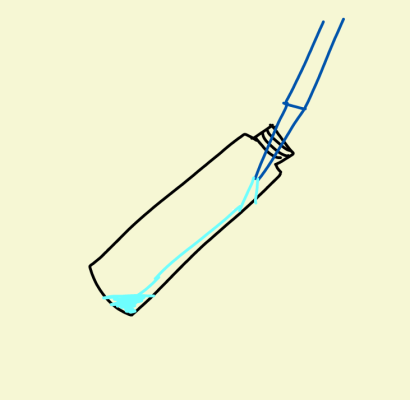- Joined
- Jul 23, 2016
- Messages
- 483
- Reaction score
- 269
GreatI have the hi707, which should be fine for this. I should be able to get you enough info to do a calibration curve on that one.
Thanks
Follow along with the video below to see how to install our site as a web app on your home screen.
Note: This feature may not be available in some browsers.
GreatI have the hi707, which should be fine for this. I should be able to get you enough info to do a calibration curve on that one.
Here is the HI-713 checker information. The test procedure is exactly the same as described above as described by @taricha, but uses the HI-713 Checker as the measurement device. This method using the HI-713 had a bit more variation at the low end of the potassium concentration (300 ppm), but is still within 10%Here's the full recipe.
First time you open the reagent, check the Exaqua reagent and stir it with the included stick to ensure uniformity. You can take the closed bottle and tap it upside down to check that all powder is liberated from the bottom corners. Then you can shake it around and thoroughly stir it. (In some cases this appeared to matter - in others it didn't.)
Recipe 2.4 E ("E" for exaqua reagent)
Video of the procedure below can be seen here. (I didn't have gloves available, but the powder inevitably gets on you so I'd recommend gloves or at least thorough handwashing right after.)
Diluted sample
1. In a Red Sea Vial, add 1.00mL of the sample water and 9.0mL of distilled water to make 10.0mL total. Swirl 15 seconds to mix. This is the Diluted sample.
Dissolving the TPB reagent
2. To a hanna cuvette, add 1 level exaqua scoop of the TPB reagent powder. Gently press against the inside of the bottle to level and finish leveling with a flat surface - I use the inside of the reagent bottle cap. Then tap the scoop to lose any extra powder not in the spoon portion.
Add the scoop carefully to the hanna cuvette. You'll have to tap more times than you think to get it all out into the cuvette.
(see 1:30 to 2:30 in the video for this tricky step)
3. Add 0.500mL distilled water to the hanna cuvette. Cap and shake vigorously for 15 sec to completely dissolve the powder reagent. Let the closed cuvette sit for ~1min to let all the TPB solution run back down to the bottom.
Reaction
NOTE: Additions to the TPB solution in the hanna reaction cuvette should be done by turning the cuvette at a 45 degree angle, slowly adding the liquid to the side of the glass and letting it flow smoothly down to the bottom. Add all liquids to the same side of the glass cuvette.

4. To the hanna cuvette, gently add 0.500mL of the Diluted sample from step 1 as described above.
5. Swirl the cuvette smoothly for 10 seconds at a modest rate - aim for 3 swirls per second.
6. Let it sit for 4 minutes.
Dilution and measurement
7. Add 10.0mL distilled water to the hanna cuvette using the same procedure above. Cap and invert the cuvette slowly and smoothly 10x. One invert and back upright every second.
8. Use a different hanna cuvette with clear water (distilled / tap) as the blank “C1”.
9. After the reacted cuvette has sat for 1-2 minutes, measure in the hanna checker.
(Optional) The sample turbidity is stable for at least half an hour, so it is possible to invert the reacted cuvette a couple more times, let it sit 1-2 minutes, re-measure and take the average. The variation is small - usually +-1 checker units in line with normal checker noise.
Calculation
for the hi764 checker - ULR nitrite (see graph of performance in previous post)
[ppm K] = ( [hi764]+12) / 0.129
In the video, my tank water at 1.026 s.g. read 45 and 43 on the checker, so 44 avg.
[ppm K] = ( [44]+12) / 0.129 = 434ppm K - this is consistent with other methods that also measured my K to be 420-450 ppm.
for the hi774 checker ULR Phosphate
[ppm K] = ( [hi774]+.103) / 0.00172

Note that this checker has a maximum of 0.90 units so as you go above 550 ppm K the meter will be at or near maxing out.
@Rick Mathew also has calibration data for the hi713 checker.
Very kind of you..
Me using your guys methods. I feel like I need a list of all these threads you guys are awesome @taricha @Rick Mathew @Dan_P
The error from my data on the hi774 would look much smaller than what was quoted for the hi764, but it's not a good comparison because the error on the hi764 was across regressions done by different people with our own checkers, different water sample matrixes (NaCl vs more complete SW) and different test kits. So inclusive of much more possible sources of error.If I understand correctly:
1. The HI-764 ULR Marine Nitrite has an error of 6%.
2. The HI-713 LR Phosphate has an error of 9% @ 400.
3. The HI-774 ULR Marine Phosphate was not given.
Can you please let me know the error on the HI-774?
The errors are not significantly different. I stated the 6% as +-1checker unit +-6% so if the 9% with the other checker were stated the same way, it'd look a bit lower and maybe not that different from the +-6%.Are the different errors noise, or do you believe that one specific checker is more accurate for this test?
I still owe y'all that loose end, unless @Rick Mathew beats me to it, he has that checker too.taricha, Any news on the HI-707 Nitrite?
The recipe as written has too much absorbance for the hi736. It's the most sensitive to low values of absorbance, but that's not the challenge here. In fact, the tank water is diluted 10:1 for the diluted sample, then only 0.50mL of that goes in the 10mL hanna checker, so the tank water dilution ends up being close to 1:200 just to make the absorbance small enough to get in range of the checkers used here.I suspect if any egg is most accurate, it would be the HI-736 ULR Phosphorous. I also suspect many on this thread have that one too.
Here is the first shot at the HI-707 work. It has not been replicated by @taricha so take it for what it is worth...It should be close being as that the basic procedure is exactly the same as published it is just using the hi-707 meter. The variability appears to be a bit higher but that might be operator (me) variability...give it a try and see if it makes sense. I will be doing my replicas in the next few days and @taricha when he gets to it but I thought I would get the initial results to you to play with.taricha, Any news on the HI-707 Nitrite? I'll be curious what the error is. I actually have that one and I suspect many on this thread also have it, since you guys figured out how to use it to test Iodine.
Gonna check back with exaqua people on this.Does anyone know where to source the reagent or have a DIY recipe?
That's not likely the largest issue here.Rick is humble to claim "operator variability" on the HI-707 error, but c'mon. Rick knows testing. The HI-707 has a 470nm wavelength. Other testers used have 525nm. Could wavelength increase error?
So I just got off the phone with the people from ELOS America. He says all of the Exaqua supplies flow through him as the main distributor....not sure if that is correct but that is what he stated. They are connected to Aquariumpartners a distributor (https://www.aquariumpartners.com/) . (Here is the Exaqua Product page for Exaqua--- https://www.aquariumpartners.com/exaqua) ....He informed me that he expects shipment from Europe at the end of this week and it will take 10-14 days to arrive in the US...So I would realistically give it a month. When I ask him about Exaqua discontinuing distribution in the US he said that was not correct....Apparently the Aquarium Specialties distributor is no longer in business...Very confusing!The Exaqua Potassium K Z450 Reagent is hard to find. aquariumspecialty.com says, "Unfortunately the Exaqua brand is no longer being distributed in the US." The wording is ominous.
Does anyone know where to source the reagent or have a DIY recipe?
I'm not up for the $121 Hach.
I agree...when you are using a instrument and making measurement at the low end or top end of the measurement range you are likely to see greater variability.That's not likely the largest issue here.
That checker has a range from 0 to 600 units, and this recipe is only using it up to below 60 units, so only the bottom less than 10% of the range. You'd definitely expect to lose some of the checker precision, when you limit yourself to a tiny fraction of its working range.
when you get them also be on the lookout for the volume of reagents being changed.Just received an email from Saltwateraquarium.
They have a limited number of Salifert test kits.
I ordered a couple.
Hope they use the same reagents
Will do.when you get them also be on the lookout for the volume of reagents being changed.
I just ordered one and it is on the way...Wonder if they got the supply chain fixed?....Some more stuff to play withJust received an email from Saltwateraquarium.
They have a limited number of Salifert test kits.
I ordered a couple.
Hope they use the same reagents
I ordered one too. I must have missed it do you know that they changed the reagents? It will be my first time using the kit.when you get them also be on the lookout for the volume of reagents being changed.
I don't know that. Just making guesses as to why availability dried up.I ordered one too. I must have missed it do you know that they changed the reagents? It will be my first time using the kit.
